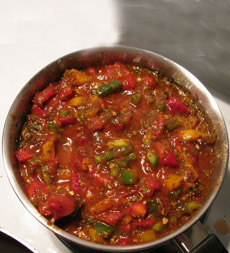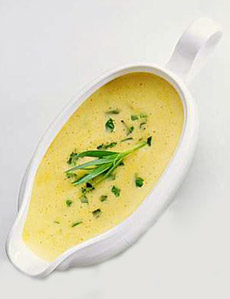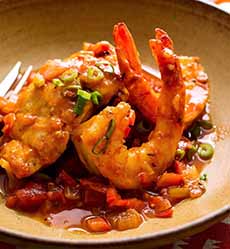Mother Sauces Part 2a: The Secondary Sauces, Creole & Béarnaise
 [1] Turn plain tomato sauce into Creole sauce (photo © Andrew Bossi | Wikipedia).
|
Earlier this week we introduced the five mother sauces, noting that each was the base for many other secondary sauces.
Today, chef Johnny Gnall explains how the secondary sauces are made. Email Chef Johnny with questions or suggestions for other cooking topics. At some point in your mastery of Escoffier’s five mother sauces, they need to be taken to the next level. Yes, tomato sauce is versatile; and a luscious, creamy béchamel is quite heavenly. But at some point you’ll yearn for variety. In the words of Emeril Lagasse, it’s time to “kick things up a notch.” Each mother sauce has a “menu” of secondary sauces, many of which can be created by adding only a few additional ingredients. The results include recent additions as well as classics that date back as far as the mother sauces themselves. Purists may follow a set of rules for what you can and can’t add to certain sauces for fear of “corrupting their integrity,” but let’s be frank: In your kitchen, you’re the boss. For the next three days, we’ll focus on two “secondary sauces” for each mother sauce, starting with a quart of mother sauce as your base. The first will be a classic secondary sauce, straight from Escoffier; the second will be my own creation or suggestion. Hopefully these suggestions will act as a jumping-off point for you to create your own sauces and dishes based on whatever it is that you like. |
|
|
6. TOMATO SAUCE BECOMES CREOLE SAUCE Creole sauce is an easy variation made with tomato sauce. You’ll be surprised at how some bell pepper can change the flavor profile of the original mother sauce. Creole sauce is delicious with chicken, fish/seafood, rice and pasta. 1. Dice half an onion, a stalk of celery and a bell pepper. Sauté them in oil along with a teaspoon of minced garlic. 2. Once the vegetables are soft, add a quart of tomato sauce, a bay leaf, a pinch of dried thyme and a teaspoon of lemon zest. 3. Simmer for 15 minutes, then season with salt, pepper and cayenne. Variation #2: Tomato Vegetable Sauce I like to build on tomato sauce simply by adding whatever seasonal vegetables I have on hand. Pretty much anything, from artichoke hearts to eggplant to zucchini, can be cleaned, diced and dropped in to simmer in the sauce. Frozen vegetables work just as well. Freezing separate portions of the plain sauce gives you many opportunities to put a new spin on it. You can make a gallon or more of tomato sauce at once, then freeze portions in quart or even pint containers. At dinnertime, just pull one out, toss it into a pot with a little water, get it simmering and add the vegetables. Serve with pasta, chicken or fish as a sauce; or even with a crusty chunk of bread—the sauce acts as a soup. |
||
|
7. HOLLANDAISE SAUCE BECOMES BÉARNAISE SAUCE Béarnaise is a more complex form of hollandaise. The key difference is in the flavoring: Hollandaise is seasoned with lemon juice while béarnaise includes shallot and tarragon with vinegar instead of lemon juice. It is named after the province of Béarn, on the southwest border of France. Unlike tomato sauce and other sauces, hollandaise/béarnaise is delicate and can’t be frozen. While hollandaise is popular with Eggs Benedict, asparagus, brussels sprouts and other green vegetables, béarnaise is typically served with steak and seafood. However, they are interchangeable, depending upon the flavors you’re looking for. 1. Combine 1 minced shallot, 1 cup of white vinegar, 1 cup of white wine, 2 teaspoons of dried tarragon and a pinch of salt and pepper in a saucepan. Reduce the mixture by three fourths. 2. Remove the pan from heat and let it cool for a minute, then add 12 egg yolks to the mixture and beat well. (Use the whites for omelets, Baked Alaska, lemon meringue pie or meringue cookies.) Continue beating over a bain-marie in the same way as you did with hollandaise. |
 Tarragon distinguishes béarnaise from hollandaise sauce (photo © Wizard Recipes). |
|
|
3. Finish by stirring in a couple of tablespoons of finely chopped parsley and a teaspoon of dried tarragon. Then, as long as you’re not cutting back on cholesterol, go all out and serve your béarnaise slathered over a nice big cut of filet mignon. Variation #2: Spicy Hollandaise Sauce Hollandaise is a great vehicle for spice, due to its richness; the texture and buttery flavor helps to soften serious heat and creates a pleasing warmth all over your palate. However, fat also conducts flavor, so a little spice goes a long way. You can keep it simple and kick up the amount of Tabasco-type hot sauce you use to season, or you can branch out: Sriracha, sambal and other hot sauces and chile pastes all work beautifully. Just whisk them into your finished sauce, adding a teaspoon or so at a time until you reach the desired heat level and consistency. Remember that hollandaise can be delicate, so too much of any one ingredient can cause it to break. To maintain the consistency of the sauce, you can substitute finely minced chiles, such as jalapeño and serrano. For the most heat, include the seeds and membrane, which contain the most capsaicin (the chemical that provides the heat). Previous: The Five Primary Mother Sauces.
|
||



